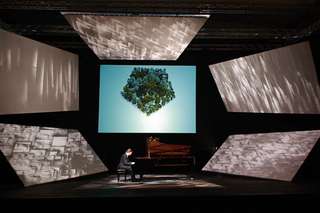|
Back
“If only”, He Whispered New York
Alice Tully Hall, Lincoln Center
11/13/2009 - & November 14 (New York), 16 (Calgary), 18 (Chapel Hill, NC), 20 (Washington, DC), 22 (Houston), 24 (Bruxelles), 27 (Moskva), 29 (Stockholm), December 1 (Hamburg), 2 (München), 4 (London), 7 (Napoli), 9 (Berlin), 11 (Paris), 13 (København), 17 (Stavanger), 18 (Oslo), 20 (Köln), 2009
Lincoln Center Presents “New Visions”: Pictures Reframed
Modest Mussorgsky: From Memories of Childhood – Pictures at an Exhibition
Robert Schumann: Kinderscenen, Opus 15
Thomas Larcher: What becomes (World Premiere)
Leif Ove Andsnes (Piano), Robin Rhode (Visual Artist), David Weiner (Lighting Design)

L. O. Andsnes at piano (art by R. Rhode)
(© EMI Classics and Perry Rubenstein Gallery, New York © NRK)
Schoenberg refused to write music for movies unless the actors spoke-sang their lines. Rossini never ate in a restaurant with music (“An insult to the musicians and the chefs.”) One can name on two fingers the great operas based on Shakespeare.
Facing facts, except for lieder and ballet, two distinct arts at their best go together as uncomfortably as Beluga and Burgundy, tending to cancel themselves out.
So as I sat happily through 80 uninterrupted minutes of pictures and music, I thought to myself, “If only Leif Ove Andsnes wasn’t one of the most glorious and adventurous pianists in the world. If only Robin Rhode wasn’t such a consummate painter and video artist. If only Modest Mussorgsky hadn’t written a work which was so dangerous, wicked, graphic and glorious at the same time.”
The “ifs” hardly detracted from the evening, for it was filled with surprises. On the art, the stage had two large screens on each side reflecting the images on the main large screen at the center. This screen had short video subjects for the first three works (which were played against a vaguely green image of what could have been asparagusses or bones or DNA genomes). For Pictrures at an Exhibition, though, Mr. Rhodes gave each picture a different and often visionary concept.
The visions were, above all, clean, reflecting Mussorgsky’s original architect-artist. Against beige or white backgrounds, the figures moved or segueed into each other with utmost fluidity. The Promenades, for instance, had one character dressed in black, walking across the screen, doing yoga-like calisthenics (real), his legs creating cloud formations (drawn). Later, in honor of the composer’s alcoholism, that figure goes wobbling down the hall.
Mussorgsky’s Medieval Castle started with an aerial shot of a pentagonal forest (real) against a white background. Fluidly the camera rose, and the forest was transformed into metallic shapes, and on the side appeared human figures. As for Baba Yaga, who could resist the live videos of a chicken crossing the road, this against South African magic cloths with chicken motifs.
The piano itself had its own visions. In Gnomus, we follow piano-wire thin lines, across a beige background. Limogesshows hands of a pianist (Andsnes?) across a keyboard where the black keys disappear, the fingers are in opposition to the real music, the keyboard becomes utterly white. And in the grand Great Gate of Kiev, Mr. Rhode takes an image from Polanski’s early Two Men and a Piano, where a piano comes out from the sea. Here, the piano is part of a slow-moving tsunami, the piano submerged finally under the sea, like a lost treasure.
(I was hoping for a notice in the program: “No pianos or any musical instruments were harmed during the making of these visual arts.”)
Some of the concepts didn’t work. Bydlo (Cattle) had a train rolling to a halt in a station, then moving on. The music, though, is far too exciting for a mere train. (Rhode explains that he is also referring to Jews moving to concentration camps, but that is hardly evident). And that soggy piano simply doesn’t have any resemblance to The Great Gate of Kiev. Perhaps he should have left the screen blank.
As for Mr. Andsnes, the man is a marvel. His first rare piano works by Mussorgsky, lasting a few minutes, were elegant enough. What Becomes, composed by Thomas Larcher for this concert, using keys and piano wires, had the simplest streamlined passages. Pianist Larcher is best known for his complex music, but this was a concert which would have (in Mr. Andsnes’s words) “the spirit of children”.

L. O. Andsnes and R. Rhode (© Tore Zakariassen © NRK)
It had, instead, the spirit of two very special artists, who obviously admire each other’s works, who have tried to create a new expression and a new form.
That new form was at its best with the ultimate “children-spirited” work, Schumann’s Scenes from Childhood. Prior to the music, Mr. Rhode had produced what looked like an Edwardian lithograph. Against a white background and a stationary camera (the only special effects being exchanges of photographic positives and negatives), a child walks and lights a candle, and the candle flames rises up. The screen now goes dark, and Mr. Andsnes begins From foreign lands and people with a rolling velvety cantabile.
This was the ideal partnership of vision, metaphor and music. The other 80 minutes flew by as gracefully as the piano wires of Messrs Andsnes and Rhode. If only (one whispers to oneself) their evidently friendly alliance had been transubstantiated into a fresh physical and spiritual alloy.
Harry Rolnick
|